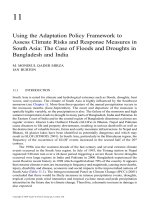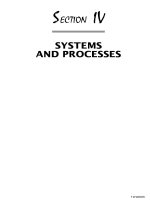Stastical technologies in business economics chapter 11
Bạn đang xem bản rút gọn của tài liệu. Xem và tải ngay bản đầy đủ của tài liệu tại đây (776.33 KB, 38 trang )
Two-sample Tests of Hypothesis
Chapter 11
McGraw-Hill/Irwin
©The McGraw-Hill Companies, Inc. 2008
GOALS
Conduct a test of a hypothesis about the difference between two independent population
means.
Conduct a test of a hypothesis about the difference between two population proportions.
Understand the difference between dependent and
Conduct a test of a hypothesis about the mean difference between paired or dependent
observations.
independent samples.
Comparing two populations – Some
Examples
Is there a difference in the mean value of residential real estate sold by male agents and female agents
in south Florida?
Is there a difference in the mean number of defects produced on the day and the afternoon shifts at
Kimble Products?
Is there a difference in the mean number of days absent between young workers (under 21 years of
age) and older workers (more than 60 years of age) in the fast-food industry?
Is there is a difference in the proportion of Ohio State University graduates and University of Cincinnati
graduates who pass the state Certified Public Accountant Examination on their first attempt?
Is there an increase in the production rate if music is piped into the production area?
Comparing Two Population Means
No assumptions about the shape of the populations are required.
The samples are from independent populations.
The formula for computing the value of z is:
Use if sample sizes > 30
or if σ 1 and σ 2 are known
z=
X1 − X 2
σ 12 σ 22
+
n1 n2
Use if sample sizes > 30
and if σ 1 and σ 2 are unknown
z=
X1 − X 2
s12 s22
+
n1 n2
EXAMPLE 1
The U-Scan facility was recently installed at the Byrne
Road Food-Town location. The store manager would
like to know if the mean checkout time using the
standard checkout method is longer than using the UScan. She gathered the following sample information.
The time is measured from when the customer enters
the line until their bags are in the cart. Hence the time
includes both waiting in line and checking out.
EXAMPLE 1
continued
Step 1: State the null and alternate hypotheses.
H0: µS ≤ µU
H1: µS > µU
Step 2: State the level of significance.
The .01 significance level is stated in the problem.
Step 3: Find the appropriate test statistic.
Because both samples are more than 30, we can use z-distribution as the test statistic.
Example 1 continued
Step 4: State the decision rule.
Reject H0 if
Z > Zα
Z > 2.33
Example 1 continued
Step 5: Compute the value of z and make a decision
z=
=
Xs − Xu
σ s2 σ u2
+
ns nu
5.5 − 5.3
2
2
0.40 0.30
+
50
100
0.2
=
= 3.13
0.064
The computed value of 3.13 is larger than the
critical value of 2.33. Our decision is to reject the
null hypothesis. The difference of .20 minutes
between the mean checkout time using the
standard method is too large to have occurred by
chance. We conclude the U-Scan method is
faster.
Two-Sample Tests about Proportions
Here are several examples.
The vice president of human resources wishes to know whether there is a difference in the proportion of
hourly employees who miss more than 5 days of work per year at the Atlanta and the Houston plants.
General Motors is considering a new design for the Pontiac Grand Am. The design is shown to a group of
potential buyers under 30 years of age and another group over 60 years of age. Pontiac wishes to know
whether there is a difference in the proportion of the two groups who like the new design.
A consultant to the airline industry is investigating the fear of flying among adults. Specifically, the company
wishes to know whether there is a difference in the proportion of men versus women who are fearful of flying.
Two Sample Tests of Proportions
We investigate whether two samples came from populations with an equal proportion of
successes.
The two samples are pooled using the following formula.
Two Sample Tests of Proportions
continued
The value of the test statistic is computed from the following formula.
Two Sample Tests of Proportions Example
Manelli Perfume Company recently developed a new fragrance that
it plans to market under the name Heavenly. A number of market
studies indicate that Heavenly has very good market potential. The
Sales Department at Manelli is particularly interested in whether
there is a difference in the proportions of younger and older women
who would purchase Heavenly if it were marketed. There are two
independent populations, a population consisting
of the younger women and a population consisting of the older
women. Each sampled woman will be asked to smell Heavenly and
indicate whether she likes the fragrance well enough to purchase a
bottle.
Two Sample Tests of Proportions Example
Step 1: State the null and alternate hypotheses.
H0: π1 = π 2
H1: π 1 ≠ π 2
Step 2: State the level of significance.
The .05 significance level is stated in the problem.
Step 3: Find the appropriate test statistic.
We will use the z-distribution
Two Sample Tests of Proportions Example
Step 4: State the decision rule.
Reject H0 if
Z > Zα/2 or Z < - Zα/2
Z > 1.96 or Z < -1.96
Two Sample Tests of Proportions Example
Step 5: Compute the value of z and make a decision
The computed value of 2.21 is in the area of rejection. Therefore, the null hypothesis is
rejected at the .05 significance level. To put it another way, we reject the null hypothesis
that the proportion of young women who would purchase Heavenly is equal to the
proportion of older women who would purchase Heavenly.
Two Sample Tests of Proportions –
Example (Minitab Solution)
Comparing Population Means with Unknown
Population Standard Deviations (the Pooled t-test)
The t distribution is used as the test statistic if one or more of the samples have less than
30 observations. The required assumptions are:
1.
Both populations must follow the normal distribution.
2.
The populations must have equal standard deviations.
3.
The samples are from independent populations.
Small sample test of means continued
Finding the value of the test statistic requires two
steps.
1.
2.
Pool the sample standard deviations.
Use the pooled standard deviation in the
formula.
(n1 − 1) s12 + (n2 − 1) s22
s =
n1 + n2 − 2
2
p
t=
X1 − X 2
2
s p
1
1
+
n1 n2
Comparing Population Means with Unknown
Population Standard Deviations (the Pooled t-test)
Owens Lawn Care, Inc., manufactures and assembles
lawnmowers that are shipped to dealers throughout the
United States and Canada. Two different procedures
have been proposed for mounting the engine on the
frame of the lawnmower. The question is: Is there a
difference in the mean time to mount the engines on the
frames of the lawnmowers? The first procedure was
developed by longtime Owens employee Herb Welles
(designated as procedure 1), and the other procedure
was developed by Owens Vice President of Engineering
William Atkins (designated as procedure 2). To evaluate
the two methods, it was decided to conduct a time and
motion study.
A sample of five employees was timed using the Welles
method and six using the Atkins method. The results, in
minutes, are shown on the right.
Is there a difference in the mean mounting times? Use
the .10 significance level.
Comparing Population Means with Unknown Population
Standard Deviations (the Pooled t-test) - Example
Step 1: State the null and alternate hypotheses.
H0: µ1 = µ2
H1: µ1 ≠ µ2
Step 2: State the level of significance. The .10 significance level is stated in the problem.
Step 3: Find the appropriate test statistic.
Because the population standard deviations are not known but are assumed to be equal, we use the pooled t-test.
Comparing Population Means with Unknown Population
Standard Deviations (the Pooled t-test) - Example
Step 4: State the decision rule.
Reject H0 if
t > tα/2,n1+n2-2 or t < - tα/2,n1+n2-2
t > t.05,9 or t < - t.05,9
t > 1.833 or t < - 1.833
Comparing Population Means with Unknown Population
Standard Deviations (the Pooled t-test) - Example
Step 5: Compute the value of t and make a decision
(a) Calculate the sample standard deviations
Comparing Population Means with Unknown Population
Standard Deviations (the Pooled t-test) - Example
Step 5: Compute the value of t and make a decision
The decision is not to reject
the null hypothesis, because
0.662 falls in the region
between -1.833 and 1.833.
We conclude that there is no
difference in the mean times
to mount the engine on the
frame using the two methods.
-0.662
Comparing Population Means with Unknown Population
Standard Deviations (the Pooled t-test) - Example
Comparing Population Means with Unequal
Population Standard Deviations
If it is not reasonable to assume the population standard deviations
are equal, then we compute the t-statistic shown on the
right.
The sample standard deviations s1 and s2 are used in place of the
respective population standard deviations.
In addition, the degrees of freedom are adjusted downward by a
rather complex approximation formula. The effect is to
reduce the number of degrees of freedom in the test, which
will require a larger value of the test statistic to reject the
null hypothesis.









